Qualcomm Snapdragon S4 (Krait) Performance Preview - 1.5 GHz MSM8960 MDP and Adreno 225 Benchmarks
by Brian Klug & Anand Lal Shimpi on February 21, 2012 3:01 AM EST- Posted in
- Smartphones
- Snapdragon
- Qualcomm
- Adreno
- Krait
- Mobile
Power Measurements using Trepn
Measuring power draw is an interesting unique capability of Qualcomm's MDPs. Using their Trepn Profiler software and measurement hardware integrated into the MDP, we can measure a number of different power rails on the device, including power draw from each CPU core, the digital core (including video decoder and modem) and a bunch of other measures.
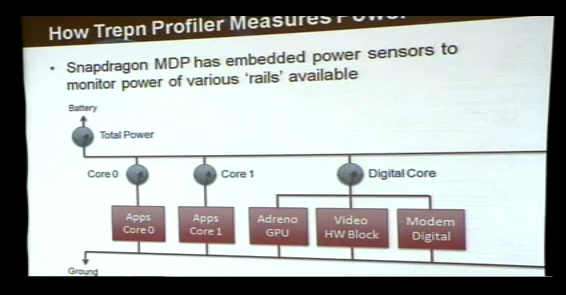
Measuring and keeping track of how different SoCs consumer power is something we've wanted to do for a while, and at least under the Qualcomm MDP umbrella at this point it's possible to measure right on the device.
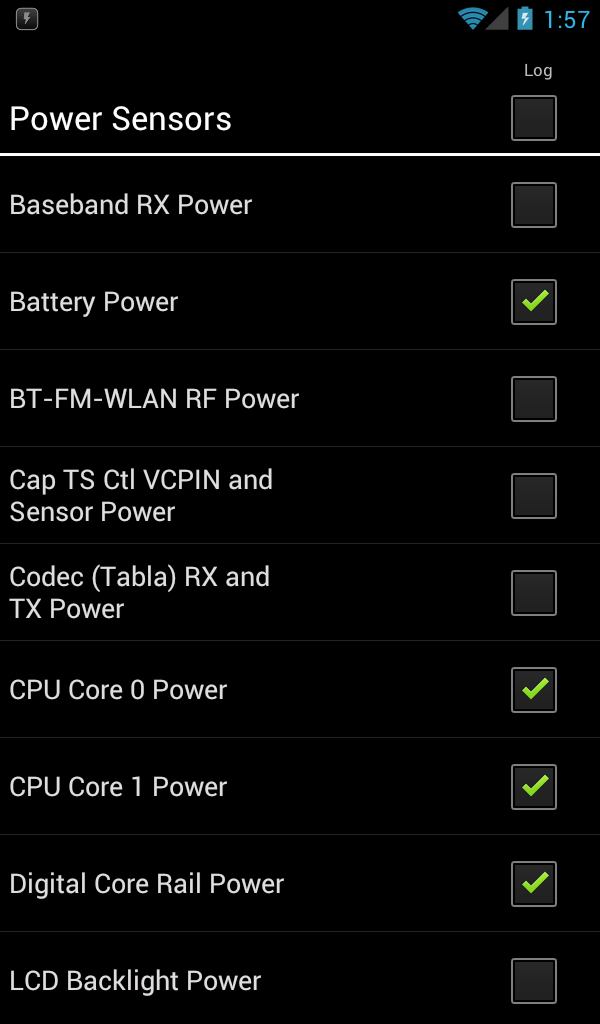
The original goal was to compare power draw on 45nm MSM8660 versus 28nm MSM8960, however we encountered stability issues with Trepn profiler on the older platform that are still being resolved. Thankfully it is possible to take measures on MSM8960, and for this we turned to a very CPU intensive task that would last long enough to get a good measure, and also load both cores so we can see how things behave. That test is the Moonbat Benchmark, which is a web-worker wraper of the sunspider 0.9 test suite. We fired up a test consisting of 4 workers and 50 runs inside Chrome beta (which is web-worker enabled), and profiled using Trepn.
If you squint at the graph, you can see that one Krait core can use around 750 mW at maximum load. I didn't enable the CPU frequency graph (just to keep things simple above) but is 750 mW number happens right at 1.5 GHz. The green spikes from battery power are when we're drawing more than the available current from USB - this is also why you see devices sometimes discharge even when plugged in. There's an idle period at the end that I also left visible - you can see how quickly Qualcomm's governor suspends the second core completely after our moonbat test finishes running.
Here's another run of moonbat on Chrome Beta where we can see the same behavior, but zoomed in a bit better - each Krait core will consume anywhere between 450 mW and 750 mW depending on the workload, which does change during our run while V8 does its JIT compilation and Chrome dispach things to each CPU.
The next big question is obviously - well how much does GPU contribute to power drain? The red "Digital Core Rail Power" lines above include the Adreno 225 GPU, video decode, and "modem digital" blocks. Cellular is disabled on the MDP MSM8960, and we're not decoding any video, so in the right circumstances we can somewhat isolate out the GPU. To find out, I profiled a run of GLBenchmark Egypt on High settings (which is an entirely GPU compute bound test) and let it run to completion. You can see how the digital rail bounces between 800 mW and 1.2 W while the test is running. Egypt's CPU portions are pretty much single-threaded as well, as shown by the yellow and green lines above.
Another interesting case is what this looks like when browsing the web. I fired up the analyzer and loaded the AnandTech homepage followed by an article, and scrolled the page in the trace above. Chrome and "Browser" on Android now use the GPU for composition and rendering the page, and you can see the red line in the plot spike up when I'm actively panning and translating around on the page. In addition, the second CPU core only really wakes up when either loading the page and parsing HTML.
One thing we unfortunately can't measure is how much power having the baseband lit up on each different air interface (CDMA2000 1x, EV-DO, WCDMA, LTE, etc.) consumes, as the MDP MSM8960 we were sampled doesn't have cellular connectivity enabled. This is something that we understand in theory (at least for the respective WCDMA and LTE radio resource states), but remains to be empirically explored. It's unfortunate that we also can't compare to the MDP MSM8660 quite yet, but that might become possible pretty quickly.


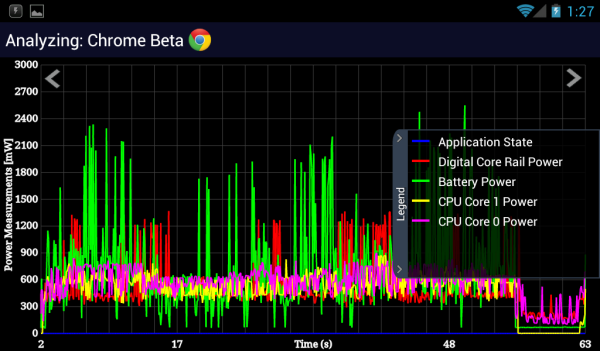
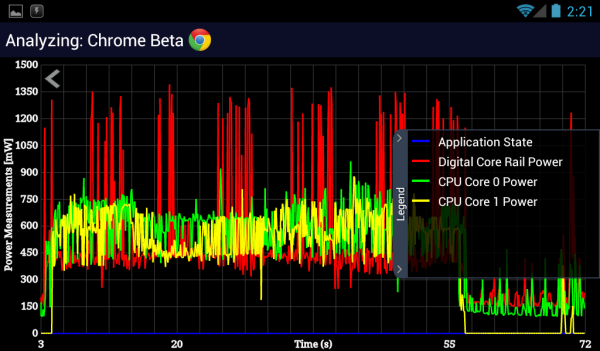
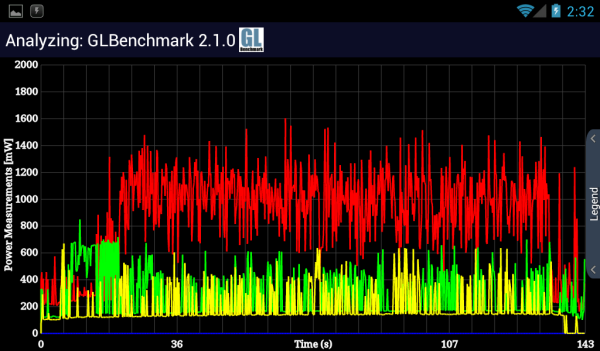
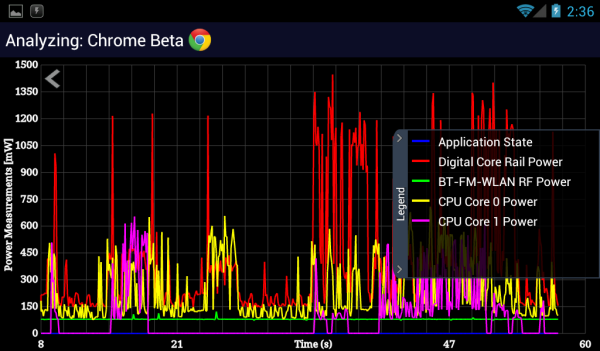








86 Comments
View All Comments
sciwizam - Tuesday, February 21, 2012 - link
Any thoughts on how Krait will compare against the A15 chips and when's the earliest will those be on market?wapz - Tuesday, February 21, 2012 - link
Look in the architecture article on page 1 here: http://www.anandtech.com/show/4940/qualcomm-new-sn..."ARM hasn't published DMIPS/MHz numbers for the Cortex A15, although rumors place its performance around 3.5 DMIPS/MHz."
Krait has 3.3 DMIPS/MHz, so if a dual Cortex A15 would run at the same frequency they would be fairly comparable I would imagine (obviously ignoring all other elements that could help performance on either of them).
wapz - Tuesday, February 21, 2012 - link
And if that's the case, HTC will have an interesting problem with their new lineup. It would mean, if the rumours are correct, their new flagship One X model using Tegra3 AP33 chipset at 1,5GHz and a 4,7 inch 720p screen might be slower compared to the One S, sporting the Snapdragon S4 chipset and a 4,3 inch screen with qHD.Lucian Armasu - Tuesday, February 21, 2012 - link
In that case even if the GPU's were equal in performance, the One S would be faster due to the fact that it uses a lower resolution.zorxd - Tuesday, February 21, 2012 - link
If by "faster", you mean more FPS in a 3D game, then yes.The resulting image quality would be lower however.
metafor - Tuesday, February 21, 2012 - link
Yes. FPS is only one factor in the overall equation of user experience. Higher resolution rendering is definitely preferable assuming one could maintain ~60fps.zorxd - Tuesday, February 21, 2012 - link
I'd rather have a 34 fps 1280x720 than a 60 fps 960x540.sosrandom - Tuesday, February 21, 2012 - link
or better graphics at 30fps @ 960x540 than 30fps @ 1280x720trob6969 - Wednesday, February 22, 2012 - link
I agree, i would take quality over speed any day as long as the difference in speed is measured in mere seconds.vol7ron - Thursday, March 1, 2012 - link
I can't wait to see the power savings, especially since the modem is a huge power draw, and one of the benefits is that QC is the manufacturer, which means integrated chip and less power consumption (as well as thinner device).